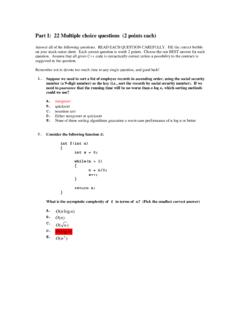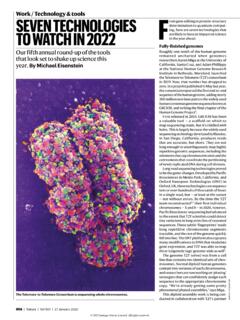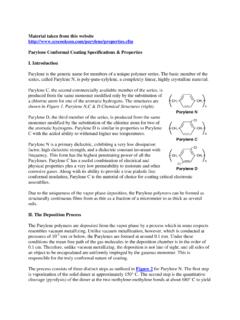Transcription of Carbon Nanotubes - University of Washington
1 Carbon Nanotubes By Chris Scoville, Robin Cole, Jason Hogg, Omar Farooque, and Archie Russell Introduction The Amazing and Versatile Carbon Chemical basis for life With an atomic number of 6, Carbon is the 4th most abundant element in the Universe by mass after (Hydrogen Helium and Oxygen). It forms more compounds that any other element, with almost 10 million pure organic compounds. Abundance, together with the unique diversity of organic compounds and their unusual polymer forming ability at the temperatures commonly encountered on Earth makes the element the chemical basis of all known life.
2 Carbon Nanotubes Carbon Nanotubes , long, thin cylinders of Carbon , were discovered in 1991 by Sumio Iijima. These are large macromolecules that are unique for their size, shape, and remarkable physical properties . They can be thought of as a sheet of graphite (a hexagonal lattice of Carbon ) rolled into a cylinder. These intriguing structures have sparked much excitement in recent years and a large amount of research has been dedicated to their understanding. Currently, the physical properties are still being discovered and disputed.
3 Nanotubes have a very broad range of electronic, thermal, and structural properties that change depending on the different kinds of nanotube (defined by its diameter, length, and chirality, or twist). To make things more interesting, besides having a single cylindrical wall (SWNTs), Nanotubes can have multiple walls (MWNTs)--cylinders inside the other cylinders. Carbon Nanotubes and Moore s Law At the rate Moore s Law is progressing, by 2019 it will result in transistor just a few atoms in width. This means that the strategy of ever finer photolithography will have run its course; we have already seen a progression from a micron, to sub micron to 45 nm scale.
4 Carbon Nanotubes , whose walls are just 1 atom thick, with diameters of only 1 to 2 nm, seems to be one of the perfect candidates to take us right to the end of Moore s Law curve. We possibly cannot go beyond that. So certainly Carbon Nanotubes has a promising future! Key properties of Carbon Nanotubes Carbon Nanotubes are an example of true nanotechnology: they are less than 100 nanometers in diameter and can be as thin as 1 or 2 nm. They are molecules that can be manipulated chemically and physically in very useful ways. They open an incredible range of applications in materials science, electronics, chemical processing, energy management, and many other fields.
5 Some properties include Extraordinary electrical conductivity, heat conductivity, and mechanical properties . They are probably the best electron field-emitter known, largely due to their high length-to-diameter ratios As pure Carbon polymers, they can be manipulated using the well-known and the tremendously rich chemistry of that element. Some of the above properties provide opportunity to modify their structure, and to optimize their solubility and dispersion. These extraordinary characteristics give CNTs potential in numerous applications.
6 Key application areas Field Emitters/Emission: Conductive or reinforced plastics Molecular electronics: CNT based non volatile RAM CNT based transistors Energy Storage CNT based fibers and fabrics CNT based ceramics Biomedical applications etc .. Timeline References properties of Carbon Nanotubes The structure of a Carbon nanotube is formed by a layer of Carbon atoms that are bonded together in a hexagonal (honeycomb) mesh. This one-atom thick layer of Carbon is called graphene, and it is wrapped in the shape of a cylinder and bonded together to form a Carbon nanotube.
7 Nanotubes can have a single outer wall of Carbon , or they can be made of multiple walls (cylinders inside other cylinders of Carbon ). Carbon Nanotubes have a range of electric, thermal, and structural properties that can change based on the physical design of the nanotube. Single-walled Carbon nanotube structure Single-walled Carbon Nanotubes can be formed in three different designs: Armchair, Chiral, and Zigzag. The design depends on the way the graphene is wrapped into a cylinder. For example, imagine rolling a sheet of paper from its corner, which can be considered one design, and a different design can be formed by rolling the paper from its edge.
8 A single-walled nanotube s structure is represented by a pair of indices (n,m) called the chiral vector. The chiral vector is defined in the image below. The structural design has a direct effect on the nanotube s electrical properties . When n m is a multiple of 3, then the nanotube is described as "metallic" ( highly conducting), otherwise the nanotube is a semiconductor. The Armchair design is always metallic while other designs can make the nanotube a semiconductor. Multi-walled Carbon nanotube structure There are two structural models of multi-walled Nanotubes .
9 In the Russian Doll model, a Carbon nanotube contains another nanotube inside it (the inner nanotube has a smaller diameter than the outer nanotube). In the Parchment model, a single graphene sheet is rolled around itself multiple times, resembling a rolled up scroll of paper. Multi-walled Carbon Nanotubes have similar properties to single-walled Nanotubes , yet the outer walls on multi-walled Nanotubes can protect the inner Carbon Nanotubes from chemical interactions with outside materials. Multi-walled Nanotubes also have a higher tensile strength than single-walled Nanotubes [7].
10 Strength Carbon Nanotubes have a higher tensile strength than steel and Kevlar. Their strength comes from the sp bonds between the individual Carbon atoms. This bond is even stronger than the sp bond found in diamond. Under high pressure, individual Nanotubes can bond together, trading some sp bonds for sp bonds. This gives the possibility of producing long nanotube wires. Carbon Nanotubes are not only strong, they are also elastic. You can press on the tip of a nanotube and cause it to bend without damaging to the nanotube, and the nanotube will return to its original shape when the force is removed.

















